Value Configurations for Data and Connectivity Solutions in Digitalized Future Factories
Abstract
:1. Introduction
- RQ1: What are the main needs and resources that are related to the digitalization of manufacturing processes in the future factory context?
- RQ2: What are potential value configurations resulting from business opportunities for data and connectivity-based solutions in the future factory context?
2. Materials
2.1. Local 5G Operators in the Factory of the Future
2.2. Business Models in Future Factories’ Business Ecosystems
2.3. Value Configurations in the Business Ecosystem
3. Research Methodology
3.1. Case Study
3.2. Data Collection and Analysis
4. Results
4.1. Identified Needs and Resources
- Internal data access emerged as both a need and a resource of future factories. On the needs side, the case factory wondered about restricted access to internal data from different segments. At the same time, from a resource perspective, sources mentioned that there is an extensive amount of data that is generated by various devices and sensors around the production line that could be utilized appropriately.
- In the high-quality connection and content-specific service theme, experts discussed future factory needs, emphasizing the importance of reliable connections and local specific demands for the communication of numerous wired and wireless devices, robots, and components on the factory floor. As the case company is empowered by 5G and IoT technologies, this theme shows considerable potential for high-quality connection and content-specific services from a resource point of view.
- Communication and data exchange reflected the importance of data exchange and the communication of different segments and stakeholders to meet existing and future demands of various segments from the standpoint of the case company’s needs. However, the case company’s willingness to communicate, exchange data, and improve the information flow (resource) between players shows that many underutilized resources can be used based on sharing economy principles.
- External data access showed the company’s awareness about valuable data, which is in control of third parties. It is undeniable that third parties need access to some data from communication with other players in the ecosystem that could be vital for the case company. Therefore, access to external data is explicitly mentioned as needed by experts. Furthermore, the case company includes some machines, robots, and services that are provided and controlled by third parties. Therefore, the extensive data gathered by such devices inside the factory floor could be considered an underutilized resource for the case company.
- Data ownership is close to the concept of external and internal access to data. Data is “owned” by different managers of different segments separately within the case company, so data management needs to be organized. However, there are large amounts of data as resources which are not managed because of different owners in different segments. Therefore, the integration between data owners could meet the company’s needs with existing resources.
- Data governance is identified as the need to process, simplify, and manage extensive data flow. Data is mainly stored in distinct segments that are not usable by other parts’ users before being processed. Conversely, the case company has an adequate reporting system and applies middleware in some parts as resources that need to be processed and managed.
- Extracting value from data is rooted in the case company’s logic on novel ideas about value creation from invaluable underutilized data. There was considerable discussion about numerous databases, including various data types as resources, which can be turned into usable forms. The factory experts emphasized that the case company is finding ways to extract value from underused data and filling the gap in data utilization in the best possible way.
- Spatial/tailored content requirements were identified as needs. Factory experts’ apparent demand and specific requirements for tailored content showed great potential for service providers in the ecosystem to meet those spatial/tailored content requirements and grow in the field.
- Data quality emphasized the decisive role of reliable and real-time data to meet the current needs of the case factory.
- Value co-creation was identified as a resource because the case company’s strategies for value co-creation can enhance the chances of collaborations in the ecosystem for other players like local operators.
- Integration requirements emerged as a resource because the case company is testing more integrated manufacturing lines that call for new services and businesses to support the integration.
4.2. 4C Business Models
4.3. Alternative Value Configurations for Local Operators
4.3.1. Product Business
4.3.2. Component Business
4.3.3. Platform Business
4.3.4. Complementary Business
5. Discussion
6. Conclusions
6.1. Theoretical Contributions
6.2. Managerial Implications
6.3. Limitations and Suggestions for Future Research
Author Contributions
Funding
Informed Consent Statement
Data Availability Statement
Conflicts of Interest
Appendix A. Structure of Future Factory Needs Based on 4C
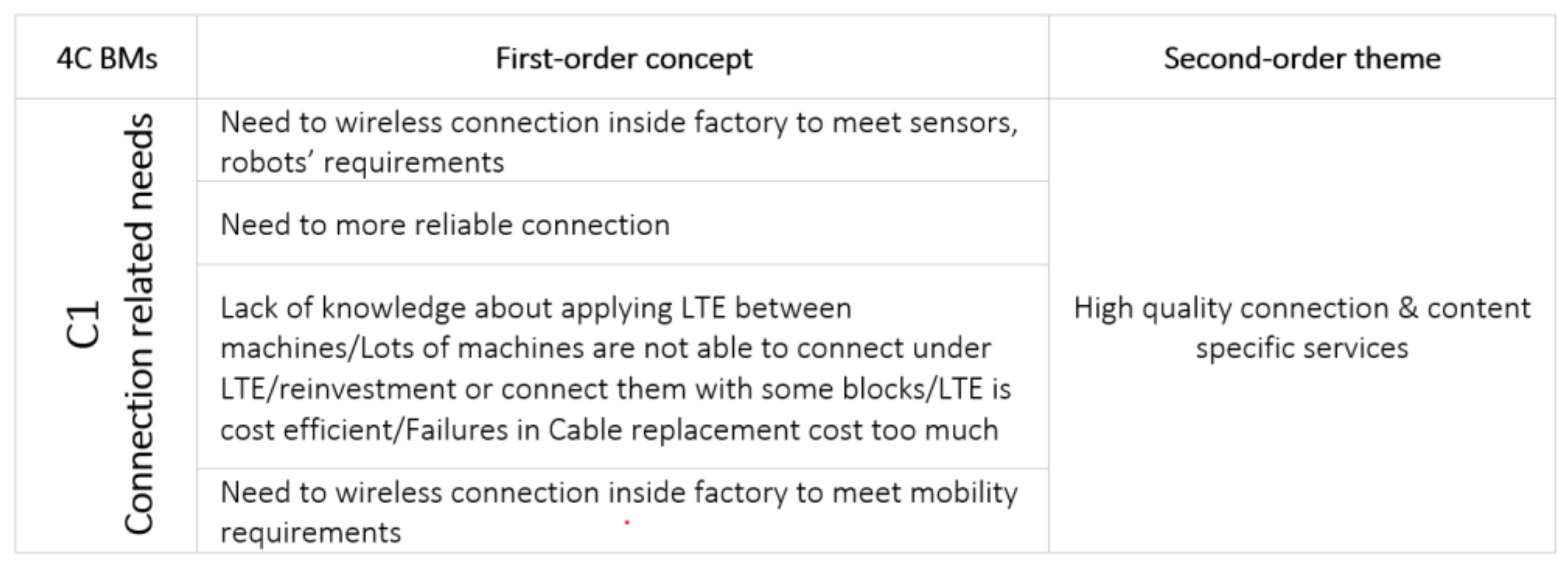
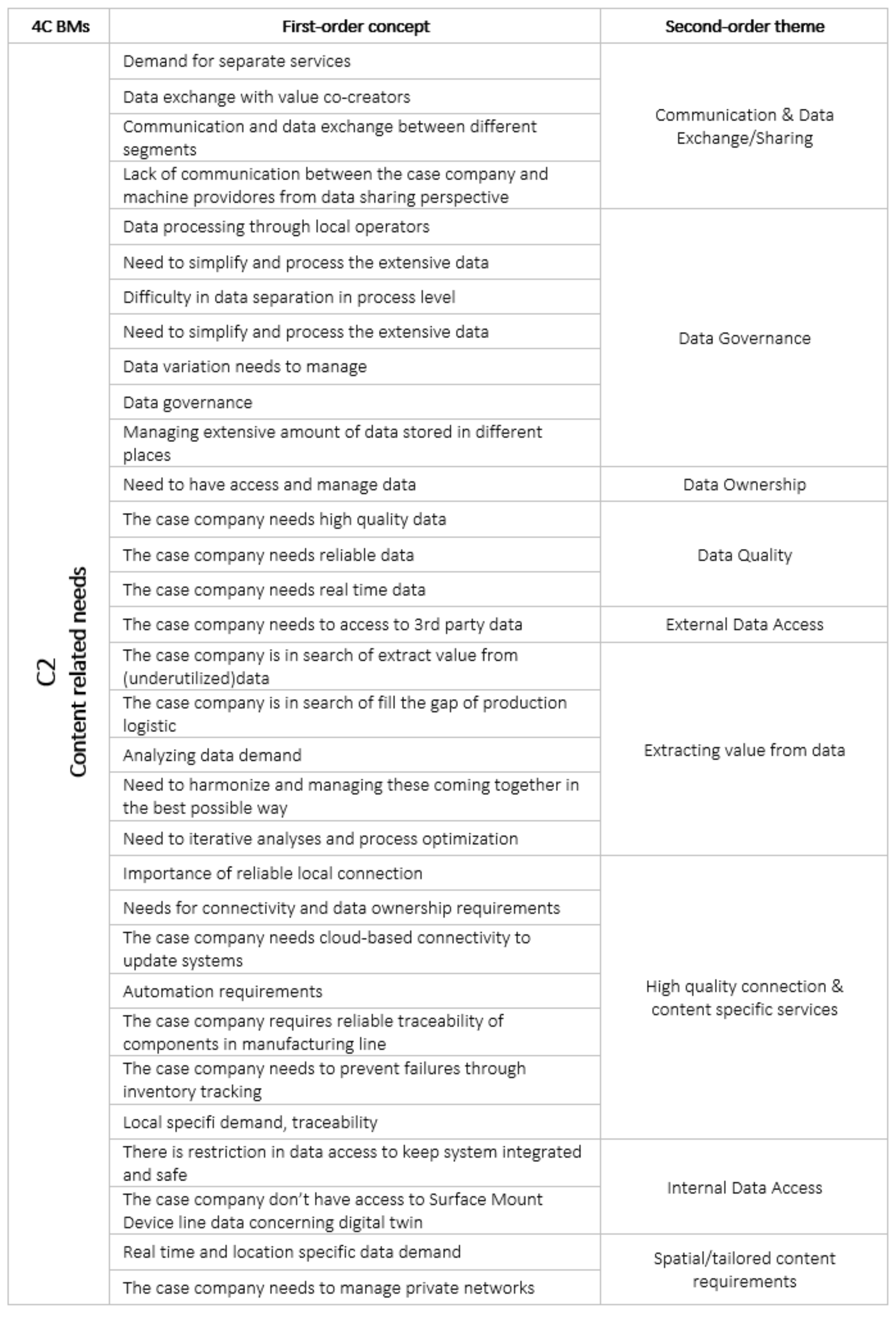

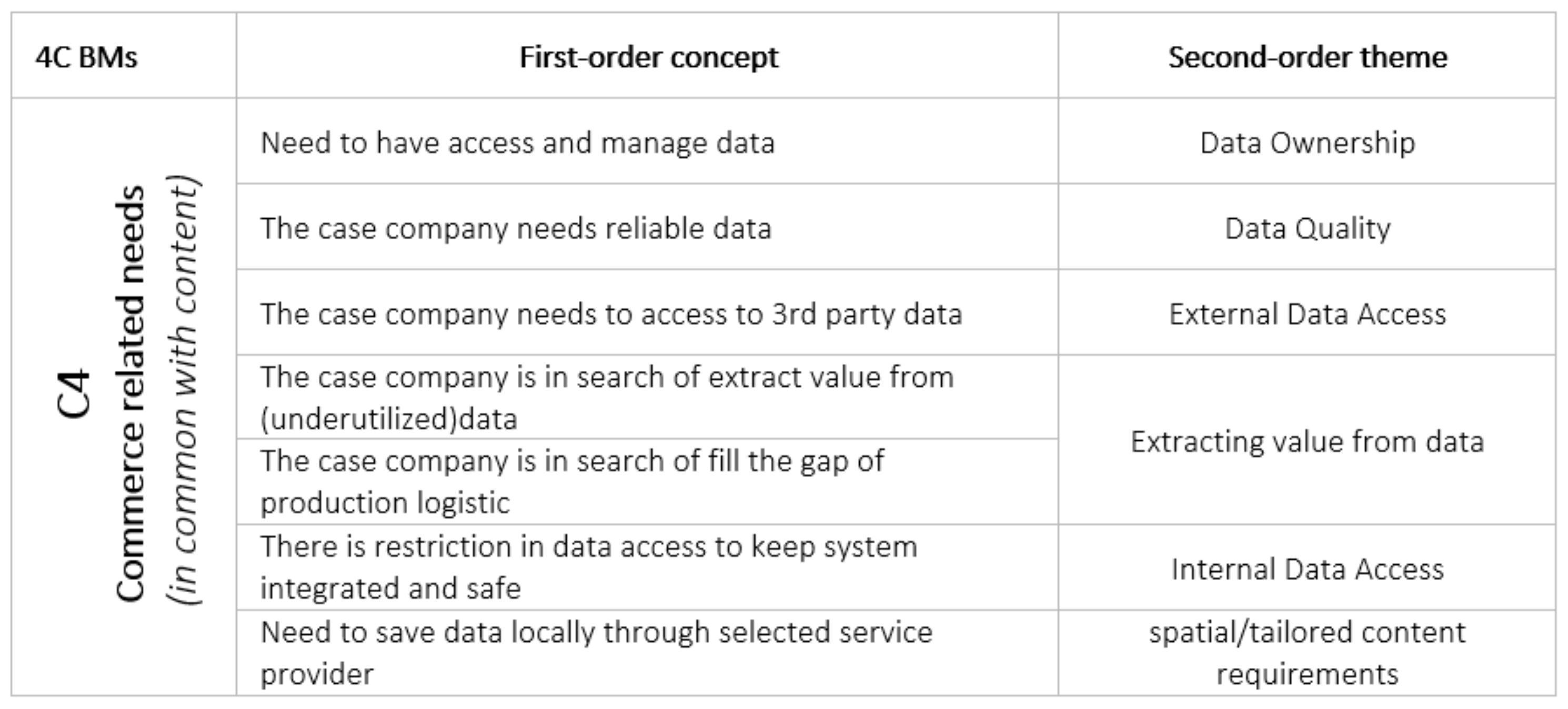
Appendix B. Data Structure of Future Factory’s Resources Based on 4C
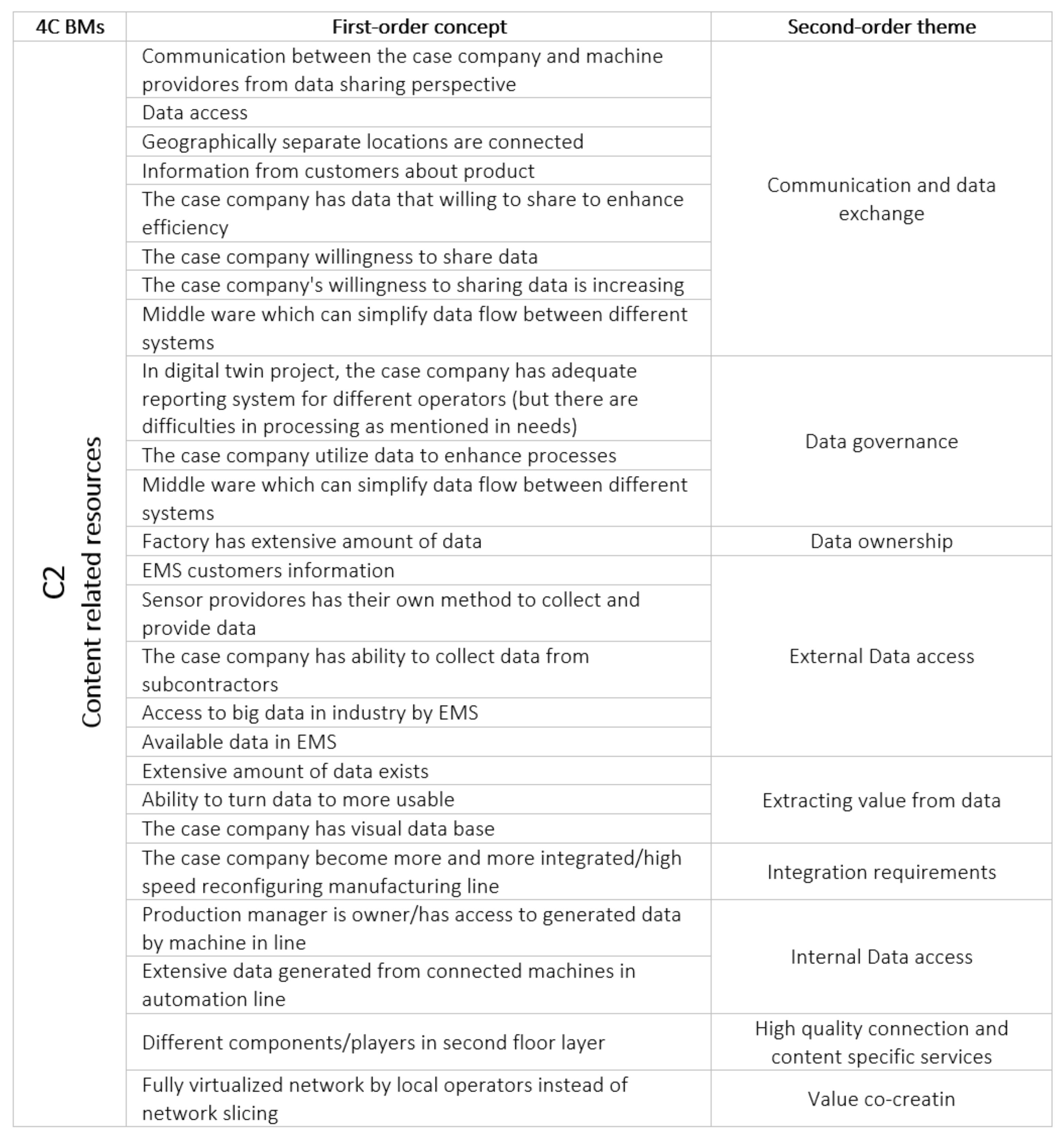

References
- Davies, R. Industry 4.0: Digitalisation for Productivity and Growth. European Parliamentary Research Service (EPRS), PE 568.337. 2015. Available online: http://www.innovation4.cn/library/r14872 (accessed on 1 December 2021).
- Putilo, N.V.; Volkova, N.S.; Antonova, N.V. Robotization in the Area of Labor and Employment: On the Verge of the Fourth Industrial Revolution. In Artificial Intelligence: Anthropogenic Nature vs. Social Origin; Popkova, E.G., Sergi, B.S., Eds.; Springer International Publishing: Cham, Switzerland, 2020; Volume 1100, pp. 60–75. [Google Scholar] [CrossRef]
- Gong, Y.; Zhang, L.; Liu, R.P.; Yu, K.; Srivastava, G. Nonlinear MIMO for Industrial Internet of Things in Cyber–Physical Systems. IEEE Trans. Ind. Inf. 2021, 17, 5533–5541. [Google Scholar] [CrossRef]
- Helmold, M.; Terry, B. Industry 4.0 and Artificial Intelligence (AI). In Operations and Supply Management 4.0; Springer International Publishing: Cham, Switzerland, 2021; pp. 77–83. [Google Scholar] [CrossRef]
- Reis, M.S.; Gao, F. Special Issue “Advanced Process Monitoring for Industry 4.0”. Processes 2021, 9, 1432. [Google Scholar] [CrossRef]
- Lee, J.; Bagheri, B.; Kao, H.-A. A Cyber-Physical Systems architecture for Industry 4.0-based manufacturing systems. Manuf. Lett. 2015, 3, 18–23. [Google Scholar] [CrossRef]
- Hermann, M.; Pentek, T.; Otto, B. Design Principles for Industrie 4.0 Scenarios. In Proceedings of the 2016 49th Hawaii International Conference on System Sciences (HICSS), Koloa, HI, USA, 5–8 January 2016; pp. 3928–3937. [Google Scholar] [CrossRef] [Green Version]
- Pujol, F.; Elayoubi, S.E.; Markendahl, J.; Salahaldin, L. Mobile Telecommunications Ecosystem Evolutions with 5G. Commun. Strateg. 2016, 102, 109159. [Google Scholar]
- Bernold, H.T.; Steiger, M.; Wilms, M.; Bock, W.; Schicht, R. A Playbook for Accelerating 5G in Europe. 2018. Available online: https://www.bcg.com/publications/2018/playbook-accelerating-5g-europe (accessed on 3 December 2021).
- Fuentes, M.; Carcel, J.L.; Dietrich, C.; Yu, L.; Garro, E.; Pauli, V.; Lazarakis, F.I.; Grondalen, O.; Bulakci, O.; Yu, J.; et al. 5G New Radio Evaluation Against IMT-2020 Key Performance Indicators. IEEE Access 2020, 8, 110880–110896. [Google Scholar] [CrossRef]
- 5G-PPP. 5G Empowering Vertical Industries. The 5G Infrastructure Public Private Partnership, Brussels. 2016. Available online: https://5g-ppp.eu/wp-content/uploads/2016/02/BROCHURE_5PPP_BAT2_PL.pdf (accessed on 10 October 2021).
- Matinmikko, M.; Latva-Aho, M.; Ahokangas, P.; Seppänen, V. On regulations for 5G: Micro licensing for locally operated networks. Telecommun. Policy 2018, 42, 622–635. [Google Scholar] [CrossRef] [Green Version]
- Matinmikko, M.; Latva-Aho, M.; Ahokangas, P.; Yrjölä, S.; Koivumäki, T. Micro Operators to Boost Local Service Delivery in 5G. Wirel. Pers. Commun. 2017, 95, 69–82. [Google Scholar] [CrossRef] [Green Version]
- Ahokangas, P.; Moqaddamerad, S.; Matinmikko, M.; Atkova, I.; Gomes, J.; Iivari, M. Future micro operators’ business models in 5G. Bus. Manag. Rev. 2016, 7, 143–149. [Google Scholar] [CrossRef]
- Berthelsen, E. A New Agenda Item for Enterprise Executives: Enterprise IoT. ThingWorx, White Paper. 2015. Available online: https://www.smartindustry.com/assets/Uploads/SI-WP-PTC-New-Agenda-Part-1.pdf (accessed on 11 October 2021).
- Yrjola, S.; Ahokangas, P.; Matinmikko-Blue, M. Novel Context and Platform Driven Business Models via 5G Networks. In Proceedings of the 2018 IEEE 29th Annual International Symposium on Personal, Indoor and Mobile Radio Communications (PIMRC), Bologna, Italy, 9–12 September 2018; pp. 1–7. [Google Scholar] [CrossRef] [Green Version]
- Ahokangas, P.; Matinmikko-Blue, M.; Yrjölä, S.; Hämmäinen, H. Platform configurations for local and private 5G networks in complex industrial multi-stakeholder ecosystems. Telecommun. Policy 2021, 45, 102128. [Google Scholar] [CrossRef]
- Chochliouros, I.P.; Kostopoulos, A.; Spiliopoulou, A.S.; Dardamanis, A.; Neokosmidis, I.; Rokkas, T.; Goratti, L. Business and market perspectives in 5G networks. In Proceedings of the 2017 Internet of Things Business Models, Users, and Networks, Copenhagen, Denmark, 23–24 November 2017; pp. 1–6. [Google Scholar] [CrossRef]
- Lourenço, J.; Almeida, F. The Impact of Emergent Technologies in the Evolutionary Path for M-Commerce. Research Anthology on E-Commerce Adoption, Models, and Applications for Modern Business. 2021. Available online: https://www.igi-global.com/chapter/the-impact-of-emergent-technologies-in-the-evolutionary-path-for-m-commerce/www.igi-global.com/chapter/the-impact-of-emergent-technologies-in-the-evolutionary-path-for-m-commerce/281537 (accessed on 2 December 2021).
- Soós, G.; Ficzere, D.; Seres, T.; Veress, S.; Németh, I. Business opportunities and evaluation of non-public 5G cellular networks—A survey. Infocommun. J. 2020, 12, 31–38. [Google Scholar] [CrossRef]
- Ahokangas, P.; Matinmikko-Blue, M.; Yrjola, S.; Seppanen, V.; Hammainen, H.; Jurva, R.; Latva-Aho, M. Business Models for Local 5G Micro Operators. IEEE Trans. Cogn. Commun. Netw. 2019, 5, 730–740. [Google Scholar] [CrossRef] [Green Version]
- Weerasinghe, N.; Hewa, T.; Liyanage, M.; Kanhere, S.S.; Ylianttila, M. A Novel Blockchain-as-a-Service (BaaS) Platform for Local 5G Operators. IEEE Open J. Commun. Soc. 2021, 2, 575–601. [Google Scholar] [CrossRef]
- Walia, J.S.; Hammainen, H.; Matinmikko, M. 5G Micro-operators for the future campus: A techno-economic study. In Proceedings of the 2017 Internet of Things Business Models, Users, and Networks, Copenhagen, Denmark, 23–24 November 2017; pp. 1–8. [Google Scholar] [CrossRef] [Green Version]
- Siriwardhana, Y.; Porambage, P.; Liyanage, M.; Walia, J.S.; Matinmikko-Blue, M.; Ylianttila, M. Micro-Operator driven Local 5G Network Architecture for Industrial Internet. In Proceedings of the 2019 IEEE Wireless Communications and Networking Conference (WCNC), Marrakesh, Morocco, 15–18 April 2019; pp. 1–8. [Google Scholar] [CrossRef] [Green Version]
- Li, X.; Guimaraes, C.; Landi, G.; Brenes, J.; Mangues-Bafalluy, J.; Baranda, J.; Corujo, D.; Cunha, V.; Fonseca, J.; Alegria, J.; et al. Multi-Domain Solutions for the Deployment of Private 5G Networks. IEEE Access 2021, 9, 106865–106884. [Google Scholar] [CrossRef]
- Matinmikko-Blue, M.; Yrjölä, S.; Ahokangas, P.; Hämmäinen, H. Analysis of 5G Spectrum Awarding Decisions: How Do Different Countries Consider Emerging Local 5G Networks? 2021. Available online: https://www.econstor.eu/handle/10419/238039 (accessed on 2 December 2021).
- Amit, R.; Han, X. Value Creation through Novel Resource Configurations in a Digitally Enabled World: Novel Resource Configurations in a Digitally Enabled World. Strat. Entrep. J. 2017, 11, 228–242. [Google Scholar] [CrossRef]
- Wirtz, B.W.; Schilke, O.; Ullrich, S. Strategic Development of Business Models. Long Range Plan. 2010, 43, 272–290. [Google Scholar] [CrossRef]
- Yrjölä, S.; Matinmikko, M.; Ahokangas, P.; Mustonen, M. Licenced shared access to spectrum. In Spectrum Sharing in Wireless Networks: Fairness, Efficiency, and Security; Matyjas, J.D., Kumar, S., Hu, F., Eds.; CRC Press: Boca Raton, FL, USA, 2016; pp. 139–157. [Google Scholar]
- Khan, I.S.; Ahmad, M.O.; Majava, J. Industry 4.0 and sustainable development: A systematic mapping of triple bottom line, Circular Economy and Sustainable Business Models perspectives. J. Clean. Prod. 2021, 297, 126655. [Google Scholar] [CrossRef]
- Burmeister, C.; Luettgens, D.; Piller, F.T. Business Model Innovation for Industrie 4.0: Why the ‘Industrial Internet’ Mandates a New Perspective. SSRN J. 2015, 70, 124–152. [Google Scholar] [CrossRef]
- Müller, J.M.; Däschle, S. Business Model Innovation of Industry 4.0 Solution Providers Towards Customer Process Innovation. Processes 2018, 6, 260. [Google Scholar] [CrossRef] [Green Version]
- Frost & Sullivan. Technology Innovations Impacting Future of Industrial Automation (Technical Insights); Frost & Sullivan: San Antonio, TX, USA, 2015; Available online: https://store.frost.com/technology-innovations-impacting-future-of-industrial-automation-technical-insights.html? (accessed on 10 November 2021).
- Knieps, G.; Bauer, J.M. Internet of things and the economics of 5G-based local industrial networks. Telecommun. Policy 2021, 102261. [Google Scholar] [CrossRef]
- Peraković, D.; Periša, M.; Zorić, P.; Cvitić, I. Development and Implementation Possibilities of 5G in Industry 4.0. In Advances in Design, Simulation and Manufacturing III; Ivanov, V., Trojanowska, J., Pavlenko, I., Zajac, J., Peraković, D., Eds.; Springer International Publishing: Cham, Switzerland, 2020; pp. 166–175. [Google Scholar] [CrossRef]
- Jovović, I.; Husnjak, S.; Forenbacher, I.; Maček, S. Innovative Application of 5G and Blockchain Technology in Industry 4.0. EAI Endorsed Trans. Ind. Netw. Intell. Syst. 2019, 6, 157122. [Google Scholar] [CrossRef]
- Şimşek, T.; Öner, M.A.; Kunday, Ö.; Olcay, G.A. A journey towards a digital platform business model: A case study in a global tech-company. Technol. Forecast. Soc. Chang. 2021, 121372. [Google Scholar] [CrossRef]
- Kandiah, G.; Gossain, S. Reinventing value: The new business ecosystem. Strat. Leadersh. 1998, 26, 28–33. [Google Scholar] [CrossRef]
- Rong, K.; Hu, G.; Lin, Y.; Shi, Y.; Guo, L. Understanding business ecosystem using a 6C framework in Internet-of-Things-based sectors. Int. J. Prod. Econ. 2015, 159, 41–55. [Google Scholar] [CrossRef] [Green Version]
- Teece, D.J. Business Models, Business Strategy and Innovation. Long Range Plan. 2010, 43, 172–194. [Google Scholar] [CrossRef]
- Cantwell, J.A. Blurred Boundaries between Firms, and New Boundaries within (Large Multinational) Firms: The Impact of Decentralized Networks for Innovation. Seoul J. Econ. 2013, 26, 1–32. [Google Scholar]
- Iivari, M. Exploring Business Models in Ecosystemic Contexts. Ph.D. Thesis, University of Oulu, Oulu, Finland, 2016. Available online: http://jultika.oulu.fi/Record/isbn978-952-62-1240-1 (accessed on 20 September 2021).
- Amit, R.; Zott, C. Crafting Business Architecture: The Antecedents of Business Model Design: Antecedents of Business Model Design. Strat. Entrep. J. 2015, 9, 331–350. [Google Scholar] [CrossRef]
- Casadesus-Masanell, R.; Ricart, J.E. Competitiveness: Business model reconfiguration for innovation and internationalization. Manag. Res. J. Iberoam. Acad. Manag. 2010, 8, 123–149. [Google Scholar] [CrossRef]
- Johnson, M.W.; Christensen, C.M.; Kagermann, H. Reinventing Your Business Model. No. December. 2008. Available online: https://hbr.org/2008/12/reinventing-your-business-model (accessed on 18 October 2021).
- Zott, C.; Amit, R. Business Model Design: An Activity System Perspective. Long Range Plan. 2010, 43, 216–226. [Google Scholar] [CrossRef]
- Chesbrough, H.W.; Appleyard, M.M. Open Innovation and Strategy. Calif. Manag. Rev. 2007, 50, 57–76. [Google Scholar] [CrossRef] [Green Version]
- Zott, C.; Amit, R. Business Model Design and the Performance of Entrepreneurial Firms. Organ. Sci. 2007, 18, 181–199. [Google Scholar] [CrossRef] [Green Version]
- Osterwalder, A. The Business Model Ontology a Proposition in a Design Science Approach. Ph.D. Dissertation, University of Lausanne, Lausanne, Switzerland, 2004. Available online: https://www.patrinum.ch/record/15985 (accessed on 10 November 2021).
- Chesbrough, H. The role of the business model in capturing value from innovation: Evidence from Xerox Corporation’s technology spin-off companies. Ind. Corp. Chang. 2002, 11, 529–555. [Google Scholar] [CrossRef] [Green Version]
- Afuah, A. Business Model Innovation: Concepts, Analysis, and Cases; Routledge: Oxfordshire, UK, 2014. [Google Scholar]
- Boillat, T.; Legner, C. From On-Premise Software to Cloud Services: The Impact of Cloud Computing on Enterprise Software Vendors’ Business Models. J. Theor. Appl. Electron. Commer. Res. 2013, 8, 7–8. [Google Scholar] [CrossRef] [Green Version]
- Ahokangas, P.; Juntunen, M.; Myllykoski, J. Cloud Computing and Transformation of International E-Business Models. In A Focused Issue on Building New Competences in Dynamic Environments; Emerald Group Publishing Limited: Bingley, UK, 2014; Volume 7, pp. 3–28. [Google Scholar] [CrossRef]
- Stabell, C.B.; Fjeldstad, Ø.D. Configuring value for competitive advantage: On chains, shops, and networks. Strat. Mgmt. J. 1998, 19, 413–437. [Google Scholar] [CrossRef]
- Fjeldstad, Ø.D.; Snow, C.C. Business models and organization design. Long Range Plan. 2018, 51, 32–39. [Google Scholar] [CrossRef]
- Casey, T.; Smura, T.; Sorri, A. Value Network Configurations in wireless local area access. In Proceedings of the 2010 9th Conference of Telecommunication, Media and Internet, Ghent, Belgium, 7–9 June 2010; pp. 1–9. [Google Scholar] [CrossRef]
- Walia, J. Techno-Economic Analysis of 5G Local Area Access in Industrial Machine-to-Machine Communications. Master’s Thesis, Aalto University, Helsinki, Finland, 2017. Available online: http://urn.fi/URN:NBN:fi:aalto-201702242554 (accessed on 10 November 2021).
- Bell, E.; Bryman, A.; Harley, B. Business Research Methods, 5th ed.; Oxford University Press: Oxford, UK, 2018. [Google Scholar]
- Myers, M.D. Qualitative Research in Business and Management, 3rd ed.; SAGE Publications: Thousand Oaks, CA, USA, 2019. [Google Scholar]
- Wilson, J. Essentials of Business Research: A Guide to Doing Your Research Project; SAGE Publications Ltd.: Thousand Oaks, CA, USA, 2010. [Google Scholar]
- Gioia, D.A.; Corley, K.G.; Hamilton, A.L. Seeking Qualitative Rigor in Inductive Research: Notes on the Gioia Methodology. Organ. Res. Methods 2013, 16, 15–31. [Google Scholar] [CrossRef]
- Krueger, R.A. Focus Groups: A Practical Guide for Applied Research; SAGE Publications: Thousand Oaks, CA, USA, 2014. [Google Scholar]
- Urciuoli, L.; Hintsa, J.; Ahokas, J. Drivers and barriers affecting usage of e-Customs—A global survey with customs administrations using multivariate analysis techniques. Gov. Inf. Q. 2013, 30, 473–485. [Google Scholar] [CrossRef]
- Rahimi, H.; Zibaeenejad, A.; Safavi, A.A. A Novel IoT Architecture based on 5G-IoT and Next Generation Technologies. In Proceedings of the 2018 IEEE 9th Annual Information Technology, Electronics and Mobile Communication Conference (IEMCON), Vancouver, BC, Canada, 1–3 November 2018; pp. 81–88. [Google Scholar] [CrossRef] [Green Version]
- Eisenmann, T.R.; Parker, J.; Alstyne, M.V. Opening platforms: How, when and why. In Platforms, Markets and Innovation; Gawer, A., Ed.; Edward Elgar Publishing: Cheltenham, UK, 2009; pp. 131–162. [Google Scholar]
- Türkeș, M.C.; Oncioiu, I.; Aslam, H.D.; Marin-Pantelescu, A.; Topor, D.I.; Căpușneanu, S. Drivers and Barriers in Using Industry 4.0: A Perspective of SMEs in Romania. Processes 2019, 7, 153. [Google Scholar] [CrossRef] [Green Version]
- Jeannerat, H.; Theurillat, T. Old industrial spaces challenged by platformized value-capture 4.0. Reg. Stud. 2021, 55, 1738–1750. [Google Scholar] [CrossRef]
- Walia, J.S.; Hämmäinen, H.; Kilkki, K.; Yrjölä, S. 5G network slicing strategies for a smart factory. Comput. Ind. 2019, 111, 108–120. [Google Scholar] [CrossRef]
- Xu, Y.; Ahokangas, P.; Turunen, M.; Mäntymäki, M.; Heikkilä, J. Xu Platform-Based Business Models: Insights from an Emerging Ai-Enabled Smart Building Ecosystem. Electronics 2019, 8, 1150. [Google Scholar] [CrossRef] [Green Version]
- Chehri, A.; Zimmermann, A. G Assisted Smart Manufacturing and Industrial Automation. In Advances in the Human Side of Service Engineering; Leitner, C., Ganz, W., Satterfield, D., Bassano, C., Eds.; Springer International Publishing: Cham, Switzerland, 2021; Volume 266, pp. 385–393. [Google Scholar] [CrossRef]
- Slalmi, A.; Chaibi, H.; Saadane, R.; Chehri, A.; Jeon, G. 5G NB-IoT: Efficient network call admission control in cellular networks. Concurr. Comput. Pract. Exp. 2021, 33, 6047. [Google Scholar] [CrossRef]

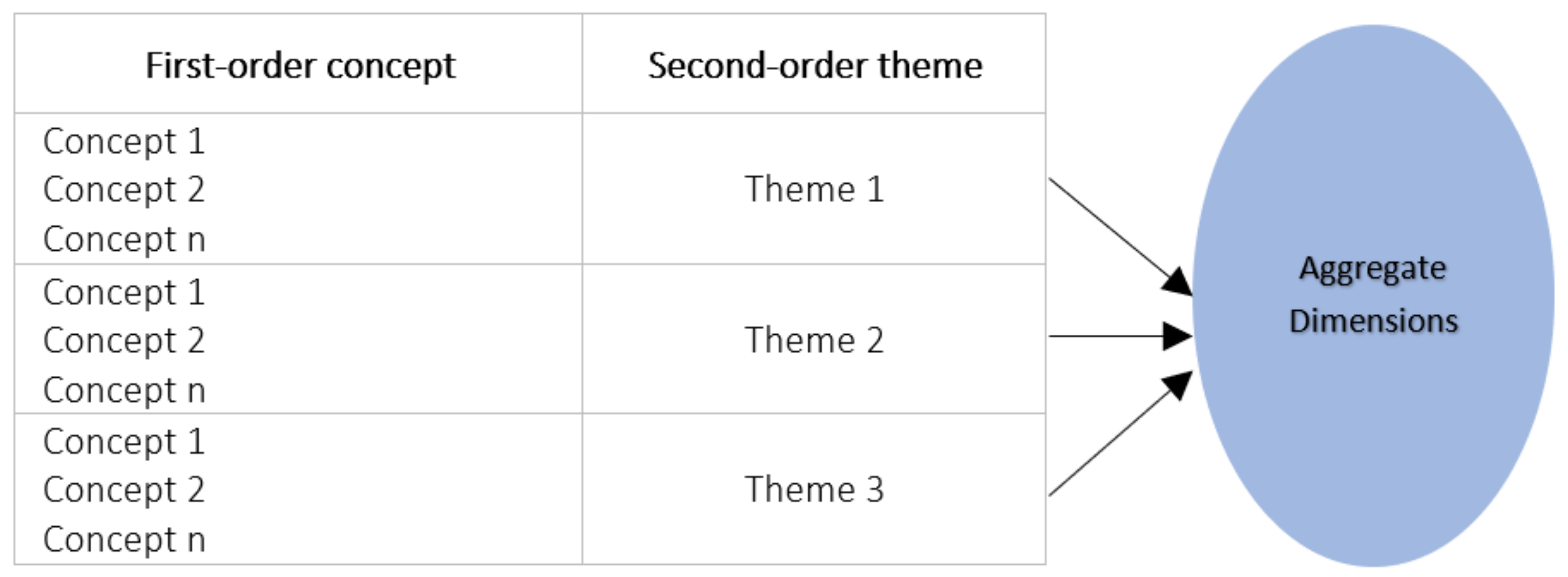

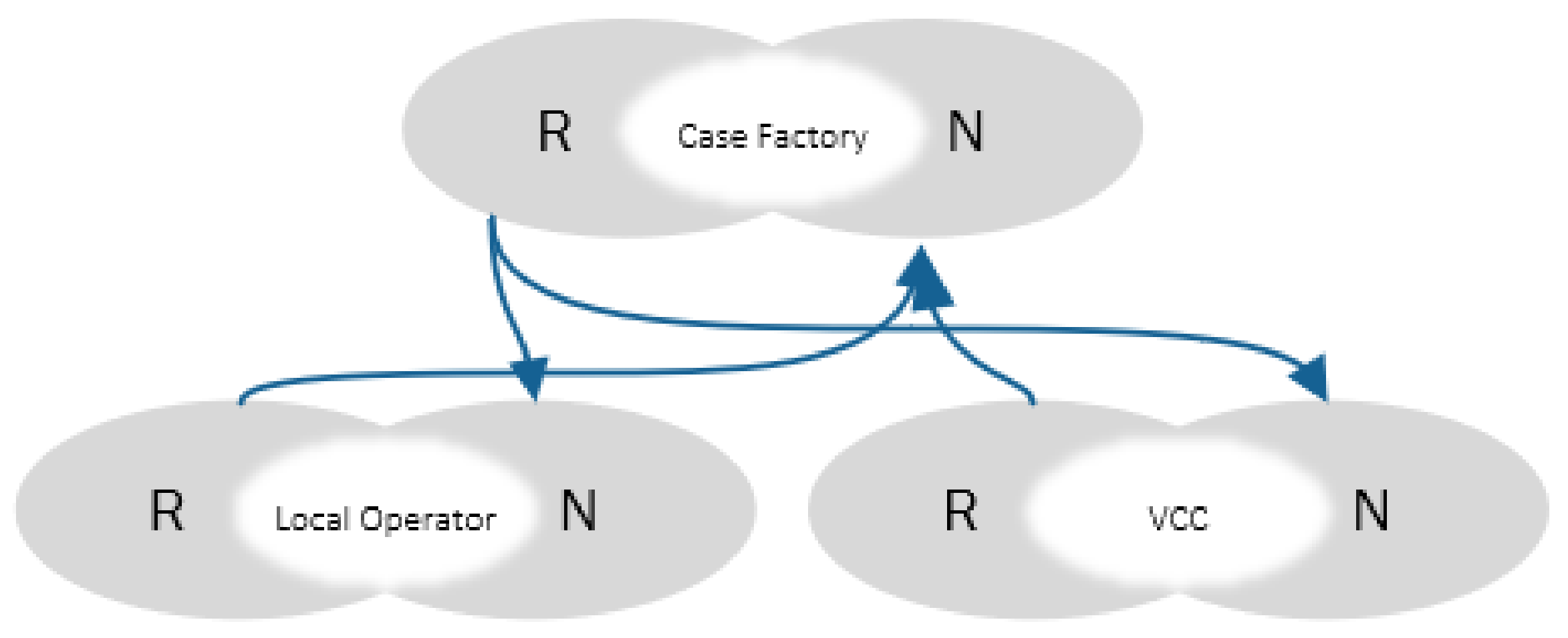

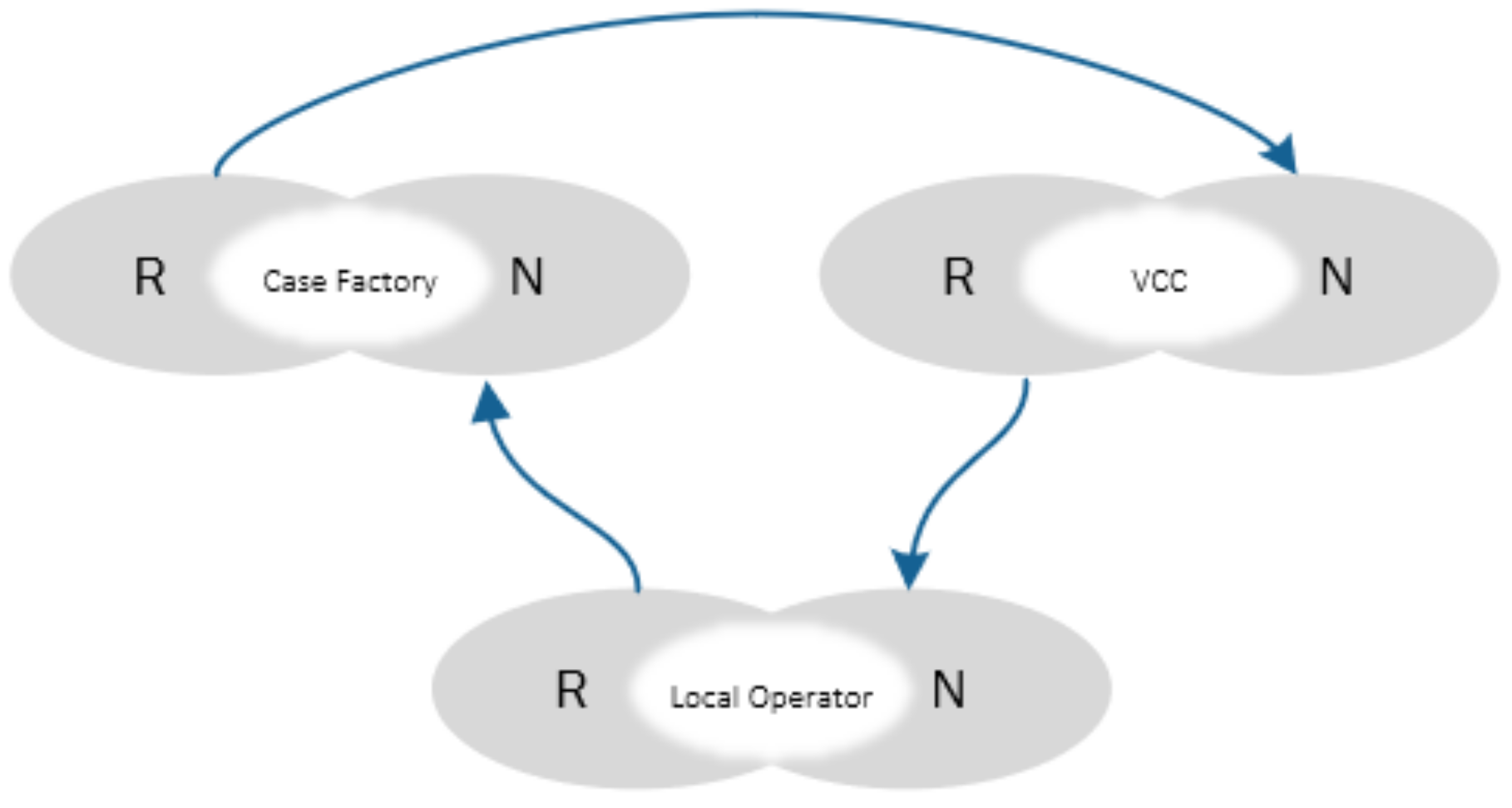
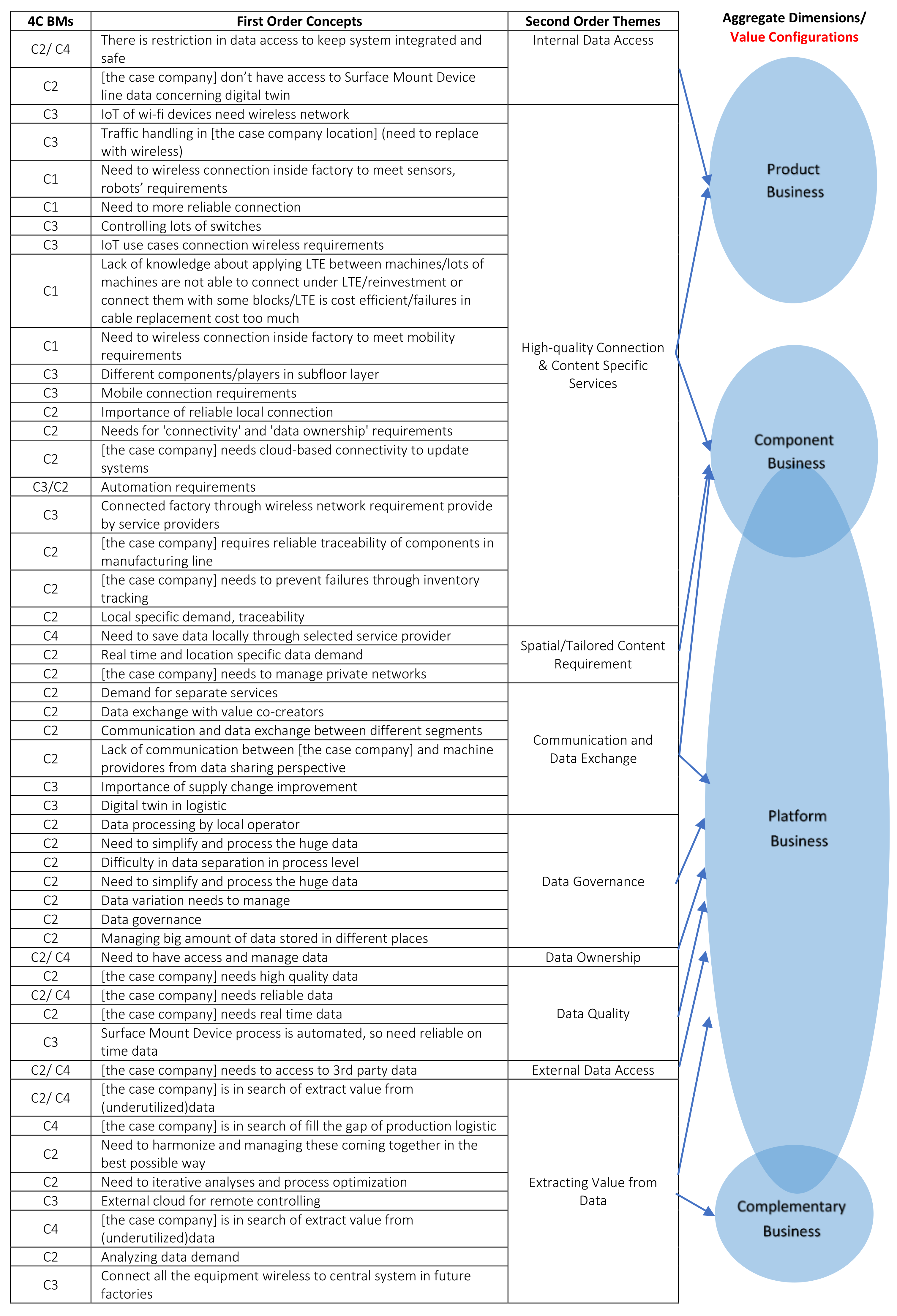

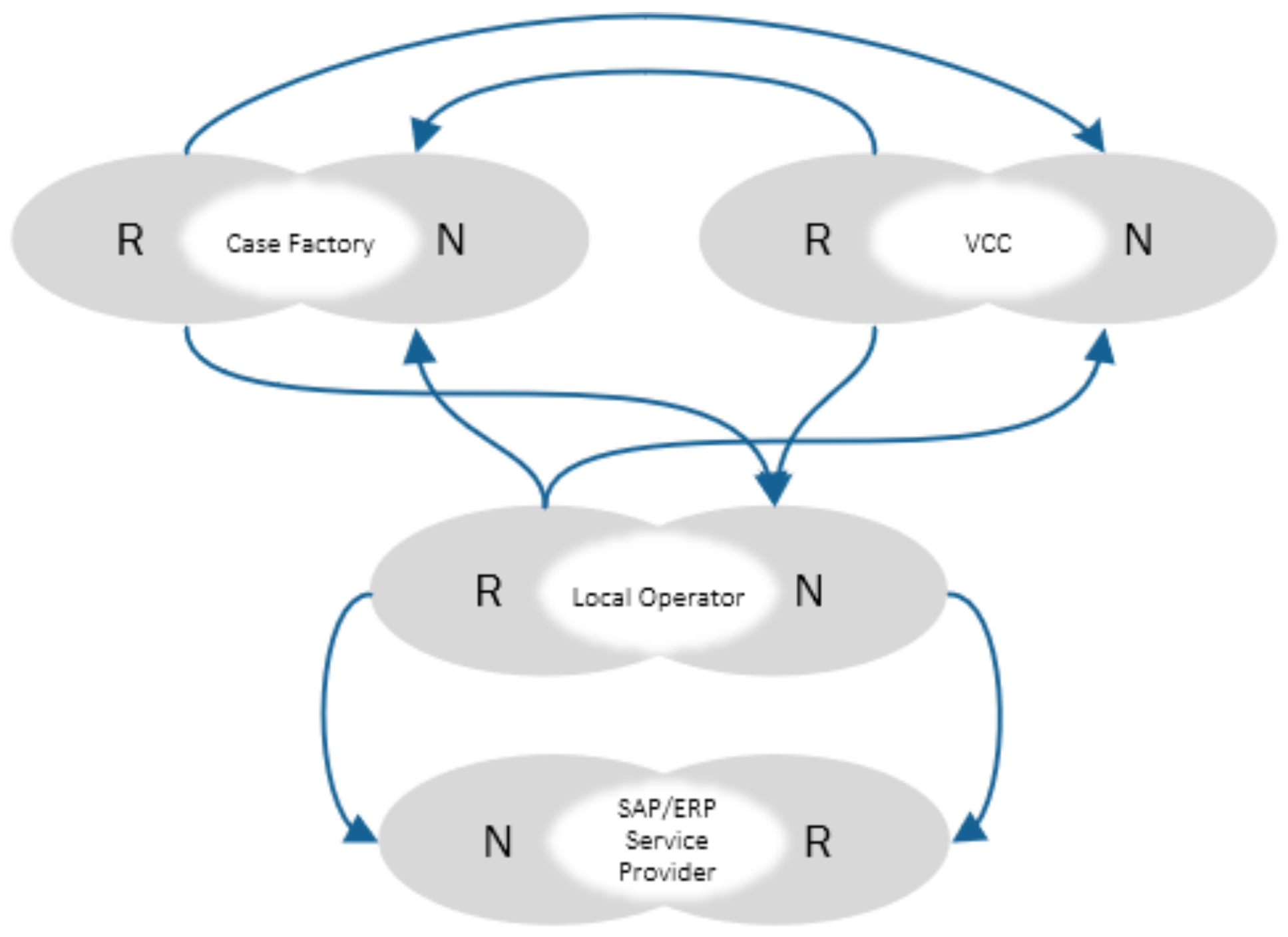

Publisher’s Note: MDPI stays neutral with regard to jurisdictional claims in published maps and institutional affiliations. |
© 2021 by the authors. Licensee MDPI, Basel, Switzerland. This article is an open access article distributed under the terms and conditions of the Creative Commons Attribution (CC BY) license (https://creativecommons.org/licenses/by/4.0/).
Share and Cite
Mansoori, S.; Khan, I.S.; Ahokangas, P.; Matinmikko-Blue, M.; Haapasalo, H.; Yrjölä, S. Value Configurations for Data and Connectivity Solutions in Digitalized Future Factories. Processes 2021, 9, 2233. https://doi.org/10.3390/pr9122233
Mansoori S, Khan IS, Ahokangas P, Matinmikko-Blue M, Haapasalo H, Yrjölä S. Value Configurations for Data and Connectivity Solutions in Digitalized Future Factories. Processes. 2021; 9(12):2233. https://doi.org/10.3390/pr9122233
Chicago/Turabian StyleMansoori, Solmaz, Iqra Sadaf Khan, Petri Ahokangas, Marja Matinmikko-Blue, Harri Haapasalo, and Seppo Yrjölä. 2021. "Value Configurations for Data and Connectivity Solutions in Digitalized Future Factories" Processes 9, no. 12: 2233. https://doi.org/10.3390/pr9122233
APA StyleMansoori, S., Khan, I. S., Ahokangas, P., Matinmikko-Blue, M., Haapasalo, H., & Yrjölä, S. (2021). Value Configurations for Data and Connectivity Solutions in Digitalized Future Factories. Processes, 9(12), 2233. https://doi.org/10.3390/pr9122233







